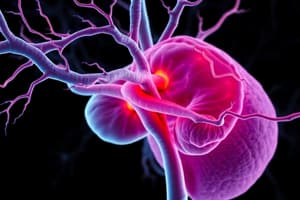Podcast
Questions and Answers
Which of the following BEST describes the primary purpose of compendial standards?
Which of the following BEST describes the primary purpose of compendial standards?
- To standardize packaging and labeling requirements for all pharmaceuticals.
- To control the manufacturing processes of drug products.
- To establish minimum quality requirements for drug substances and products. (correct)
- To define acceptable product attributes specifically at the point of release.
What is the MAIN purpose of 'Uniformity of Dosage Units' as a quality attribute?
What is the MAIN purpose of 'Uniformity of Dosage Units' as a quality attribute?
- To measure the weight variations across different batches.
- To confirm the presence of the correct active pharmaceutical ingredient.
- To ensure the drug dissolves at a consistent rate.
- To verify that each tablet or capsule contains the same amount of the API. (correct)
Which quality attribute is MOST directly assessed by measuring the rate at which the API is released from a dosage form?
Which quality attribute is MOST directly assessed by measuring the rate at which the API is released from a dosage form?
- Content Uniformity
- Weight Variation
- Dissolution (correct)
- Purity
Why is disintegration important for solid dosage forms like tablets and capsules?
Why is disintegration important for solid dosage forms like tablets and capsules?
Which factor is LEAST likely to influence compendial requirements for a solid dosage form?
Which factor is LEAST likely to influence compendial requirements for a solid dosage form?
According to the Noyes-Whitney equation, what does 'Cs' represent?
According to the Noyes-Whitney equation, what does 'Cs' represent?
Which of the following mechanisms of tablet disintegration involves liquid being drawn into the tablet?
Which of the following mechanisms of tablet disintegration involves liquid being drawn into the tablet?
What does the term 'friability' refer to in the context of tablet testing?
What does the term 'friability' refer to in the context of tablet testing?
Which statement is TRUE regarding semi-solid dosage forms (SSDs)?
Which statement is TRUE regarding semi-solid dosage forms (SSDs)?
In an oil-in-water emulsion, which substance forms the continuous phase?
In an oil-in-water emulsion, which substance forms the continuous phase?
What distinguishes a suspension from a solution?
What distinguishes a suspension from a solution?
What is the MAIN advantage of semi-solid formulations that allows to bypass the first-pass effect?
What is the MAIN advantage of semi-solid formulations that allows to bypass the first-pass effect?
What is the primary purpose of Atomic Absorption Spectroscopy (AAS) in pharmaceutical analysis?
What is the primary purpose of Atomic Absorption Spectroscopy (AAS) in pharmaceutical analysis?
Which instrumental method is MOST suitable for separating, identifying, and quantifying various APIs in complex liquid formulations?
Which instrumental method is MOST suitable for separating, identifying, and quantifying various APIs in complex liquid formulations?
Which analysis method is best to test for trace metal contamination?
Which analysis method is best to test for trace metal contamination?
In the diffusion layer model of drug dissolution, which process is considered the rate-determining step?
In the diffusion layer model of drug dissolution, which process is considered the rate-determining step?
What did Danckwerts' model propose regarding the dissolution process, contrasting with the diffusion layer model?
What did Danckwerts' model propose regarding the dissolution process, contrasting with the diffusion layer model?
What is the primary difference between aqueous and nonaqueous liquid dosage forms?
What is the primary difference between aqueous and nonaqueous liquid dosage forms?
What does the Interfacial Barrier Model propose limits the rate of dissolution?
What does the Interfacial Barrier Model propose limits the rate of dissolution?
What is the purpose of measuring 'residual solvents' during pharmaceutical testing?
What is the purpose of measuring 'residual solvents' during pharmaceutical testing?
Flashcards
Compendial Standards
Compendial Standards
Standards that define acceptable drug articles, focusing on identity, strength, quality, purity, packaging, and labeling.
Purpose of Compendial Standards
Purpose of Compendial Standards
To ensure consistency, purity, potency, and overall quality of drug products.
Identity Test
Identity Test
Verifying the presence of the correct active pharmaceutical ingredient (API) using methods like spectroscopy and chromatography.
Assay (Potency)
Assay (Potency)
Signup and view all the flashcards
Uniformity of Dosage Units
Uniformity of Dosage Units
Signup and view all the flashcards
Dissolution
Dissolution
Signup and view all the flashcards
Rate of Dissolution
Rate of Dissolution
Signup and view all the flashcards
Diffusion Layer Model
Diffusion Layer Model
Signup and view all the flashcards
Danckwert's Model
Danckwert's Model
Signup and view all the flashcards
Interfacial Barrier Model
Interfacial Barrier Model
Signup and view all the flashcards
Disintegration test
Disintegration test
Signup and view all the flashcards
Hardness/Friability
Hardness/Friability
Signup and view all the flashcards
Semi-Solid Dosage (SSD)
Semi-Solid Dosage (SSD)
Signup and view all the flashcards
Continuous Phase
Continuous Phase
Signup and view all the flashcards
Dispersed phase
Dispersed phase
Signup and view all the flashcards
Emulsion (Oil-in-Water)
Emulsion (Oil-in-Water)
Signup and view all the flashcards
Suspension (Solid in Liquid)
Suspension (Solid in Liquid)
Signup and view all the flashcards
Solution
Solution
Signup and view all the flashcards
Dispersion
Dispersion
Signup and view all the flashcards
High-Performance Liquid Chromatography (HPLC)
High-Performance Liquid Chromatography (HPLC)
Signup and view all the flashcards
Study Notes
Compendial Standards
- Define acceptable articles at the time of use
- Establishment of drug names and requirements for identity, strength, quality, purity, packaging, storage, and labeling
- Solid oral dosage forms of drugs are used most frequently in drug therapy.
- Compendial requirements for solid dosage forms concern quality standards
- Standards are set by pharmacopeias such as USP and Ph. Eur.
Purpose of Compendial Standards
- Establishes minimum quality requirements for drug substances and products
- Aims to ensure consistency, purity, potency, and overall quality
- Legally recognized in many countries
Key Compendia
- United States Pharmacopeia (USP)
- European Pharmacopoeia (Ph. Eur.)
- Japanese Pharmacopoeia (JP)
Quality Attributes and Tests
- Identity ensures the correct active pharmaceutical ingredient (API) is present
- Uses spectroscopic techniques (IR, UV), chromatography (HPLC), and chemical tests
- Assay (Potency) determines the quantity of API in the dosage form
- Primarily uses HPLC
- Uniformity of Dosage Units ensures each unit contains the correct amount of API
Tests
- Content uniformity measures API content of individual units, verifies even distribution,
- Weight variation measures weight of individual units and the degree to which weights differ
Dissolution
- Process in which a solid substance solubilizes in a given solvent
- Rate of Dissolution measures the amount of drug that goes into solution per unit time, releases the API, crucial for assessing bioavailability
- Standardized dissolution apparatus and conditions
- Not performed in sustained release tablet preparation; directly undergo Dissolution because of the low rate of dissolution
- Deaggregation is the further breakdown into even smaller particles
Basic Theories
- Diffusion Layer Model (Film Theory) involves two steps:
- Solution of the solid to form a stagnant film or diffusive layer that is saturated
- Diffusion of the soluble solute from the stagnant layer to the bulk of the solution
- Steps 1 which is usually rapid
- Step 2 is slow and rate determining
- Danckwert’s Model (Penetration or Surface renewal Theory)
- Ruled out the existence of stagnant layer
- There is a turbulence of dissolution medium where there is a formation of eddies/water pockets in the dissolution media
- Turbulence in the dissolution medium exists at the solid/liquid interface
- Interfacial Barrier Model (Double barriers or Limited solvation Theory)
- Proposes that dissolution rate is limited by the interactions at the solid-liquid interface, where a high activation energy barrier hinders spontaneous dissolution
Noyes-Whitney Equation
- Earliest equation to explain the rate of dissolution when the process is diffusion controlled
- dC/dt = K (Cs-Cb)
- k = Dissolution rate constant (first order),
- Cs = Concentration of drug in the stagnant layer/ stagnant concentration,
- Cb = concentration of drug in the bulk of the solution at time t.
Disintegration
- Measuring the time it takes for a solid dosage form to break apart in a liquid medium
- Sufficient disintegration of tablets conducive to rapid dissolution of drugs, improves bioavailability
- Relevance for tablets and capsules
- Three major mechanisms of tablet disintegration:
- Swelling of the disintegrant overcomes adhesion forces, causing fragmentation
- Porosity and capillary action (wicking) enhance fluid penetration and rupture
- Deformation by elastic deformation/release of energy upon contact with water
- Purity limits the presence of impurities
Tests
- Related substances: Detecting and quantifying impurities.
- Residual solvents: Measuring the levels of solvents used in manufacturing.
- Microbial testing: Testing for the presence of harmful microorganisms.
- Hardness/Friability (for Tablets)
- Measure mechanical strength and ability to withstand handling and transportation
- Hardness measures the force needed to break a tablet, while friability assesses its resistance to abrasion and breakage
Moisture Content
- Also known as "Moisture Content"
- Critical quality attribute, impacts product stability, shelf-life, and overall quality
- Measures the amount of water present in the dosage form
- Excessive moisture can impact stability
- Packaging and Labeling requires packaging materials and labeling information
- Ensuring product stability and proper use
- Factors influencing compendial requirements
- Type of solid dosage form, routes of administration, drug substance properties, manufacturing process
Importance of Compendial Compliance
- Patient safety is ensuring patients receive safe and effective medications
- Regulatory compliance means meeting requirements of regulatory agencies like the FDA
- Product quality is maintaining consistent product quality throughout the shelf life
Liquid Dosage Form
- Semi-solid dosage (SSD) forms are a type of medication that is neither solid nor liquid
- Applied to skin, mucosa, cornea, tissue, membrane.
- SSD forms have oil and water phases
- Has a continuous or external phase and a dispersed, or internal phase
- Active ingredients can be dissolved in one or both phases
Continuous Phase (External Phase)
- Substance that forms the "background" or the "carrying" medium
- Phase that surrounds the dispersed phase, called "continuous"
- Dispersed Phase (Internal Phase) is broken up and spread throughout
- Examples include emulsion (oil-in-water) or (water-in-oil) and suspension (solid in liquid)
- Benefits of Semi-Solid for external use, Reduced side effects, avoiding first-pass effect, and controlled release
Significance Terms
- Solution is a homogenous mixture with drug fully dissolved
- Suspension has undissolved particles and requires shaking
- Emulsion is an oil and water mix, stabilized.
- Elixir is sweetened, hydroalcoholic solution.
- Syrup has high sugar concentration
- Tincture is an alcoholic extract
Preparation of Liquid Dosage Forms
- By dissolving the active drug substance in an aqueous or nonaqueous solvent, or by suspending the drug in an appropriate medium or by incorporating it into oil/water phases.
- Assaying liquid dosage preparations measures the concentration of the active pharmaceutical ingredient (API) within the liquid formulation
- Common Assay Methods:
- High-Performance Liquid Chromatography (HPLC) separates, identifies, and quantifies components in a liquid mixture, versatile, accurate
- Gas Chromatography (GC) analyzes volatile compounds, it's used to determine the concentration of APIs or residual solvents
- Spectrophotometry (UV-Vis) measures the absorption of ultraviolet or visible light by a substance, used for quantifying APIs
- Titration involves reacting the API with a titrant to quantify API
- Atomic Absorption Spectroscopy (AAS) determines the concentration of metallic elements, when testing for trace metal contamination
Studying That Suits You
Use AI to generate personalized quizzes and flashcards to suit your learning preferences.




